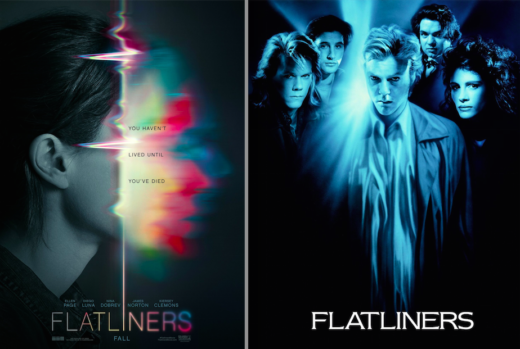So why do we have not one, but two versions of this thing now? The answer isn't as simple as, in Vice's words: "Hollywood's Obsession with Remakes and Sequels."
It's true that 1990's Flatliners was, at times, a tad overwrought. The students inhabited a world of perpetual dusk and non-stop roadworks in a city that was constantly spewing steam out of invisible sidewalk grates, to a sometimes ridiculous extent. The medical students' motivations were muddy and unconvincing at times. Plus, some of the students' "crimes" were, from one perspective, pretty laughable (schoolyard bullying being one, going into a room you're not supposed to go into being another).
But Flatliners got more right than it's often given credit for. It broached a unique, thought-provoking concept in a modern-gothic way. It whole-heartedly committed to a sort of wide-eyed wonderment that was tinged with existential dread. There is also an argument to be made that the smallness of some of the characters' prior offenses actually worked well, in that it prompted even well-behaved audience members to wonder what minor horrors they might have committed in their own lives, and what the larger consequences of those might be.
2017's Flatliners is better, in that it provides much more convincing motivations for the students to embark on such dangerous experiments (personal grief and becoming "the world's first specialist[s] in the afterlife" being two key ones), and gives them much more space to actually analyze data like they're taking this seriously in a professional capacity. They also, in a rather fun development, have much more serious crimes to atone for than the original script allowed.
The new Flatliners is effectively brought up to date with issues relating to cyber-bullying, revenge porn, and the dangers of texting and driving. Ellen Page and pals are provided with better equipment and a more realistic work setting. Most effectively of all, the update presents flatlining as a new high; something that leaves the students feeling invincible, sexually charged, and sharper mentally. It is the arrogance of youth, writ large. One student notes that they should "bottle flatlining" as the next great "party drug." Which sure beats the hell out of the sad faced, wrapped-in-a-blanket, post-death, "there are no words" semi-analyses of the original.
Both movies, of course, are products of their times. While the all-white original had one token female star (who was called "beautiful" and patronized throughout, in a manner that was intended to feel romantic), the new one features three women and two men, two of whom are people of color. It openly discusses issues around privilege and education and, briefly, being a woman in a male-dominated profession. Sex is treated realistically, rather than the glossed over, waking-up-cuddling of the original. The new Flatliners also provides more jumps and real horror imagery for harder-to-shock modern audiences.
Despite the plethora of bad reviews, and some plot holes, I would argue that both versions of Flatliners do ultimately work -- and here's why.
Historically, Hollywood, more often than not, reflects the times audiences are living in. During the Great Depression, 60-70 million economically-challenged Americans still hit the movie theater every week for films that "reinstat[ed] the mythical American values of individualism, classlessness, and progress." World War II saw a boom in tragic love stories to ease the woes of couples separated by army deployment (see: Casablanca, Brief Encounter, and Now, Voyager.) By the 1990s, as the world adjusted to living online, Hollywood was treating us to movies like The Matrix and Strange Days, both of which asked questions about virtual reality. Then, with the advent of reality television and closed-circuit surveillance, we got The Truman Show and Ed TV. You get the point.
The reason Flatliners warrants versions almost three decades apart is precisely because its themes work no matter what year it is. Issues around life, death, and morality are universal, timeless, thought-provoking, and, yes, a little scary. Even if you find the executions hokey (I don't, but that's my thing), I would argue that it's difficult to leave a viewing of either version of Flatliners without doing a little self-examination and even perhaps, some semi-panicked atonement.
Flatliners might not provide the kind of escapism we want (need?) in 2017, but its themes around mistakes and redemption give us some hope in today's chaotic political climate. Plus, aside from anything else, a little bit of self-reflection never hurt anybody.


